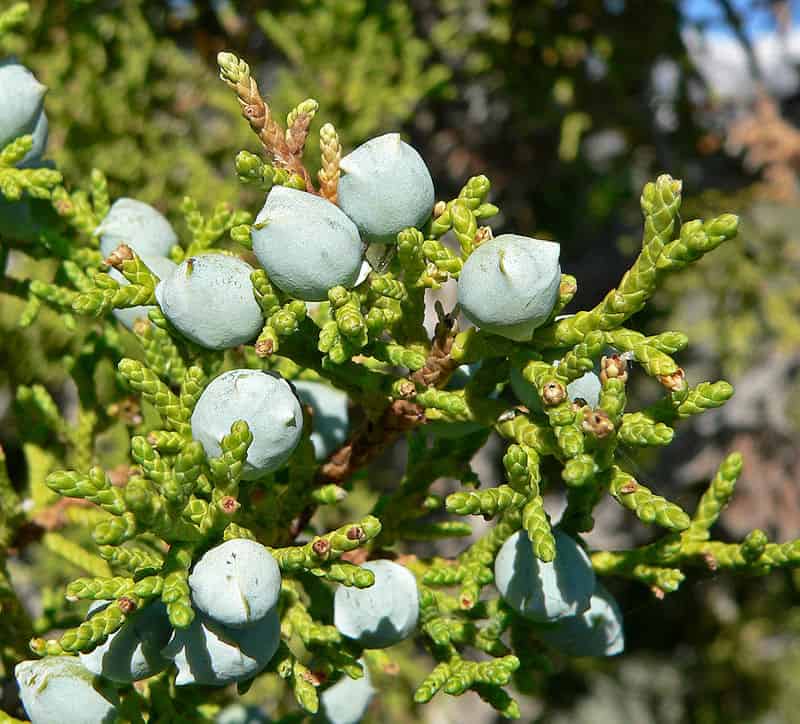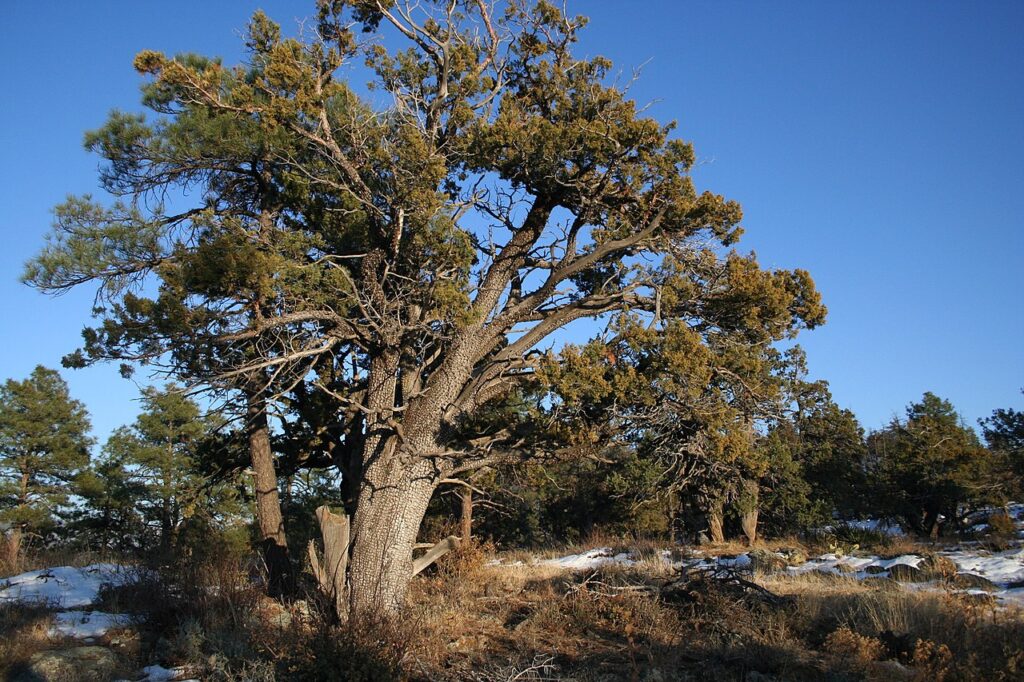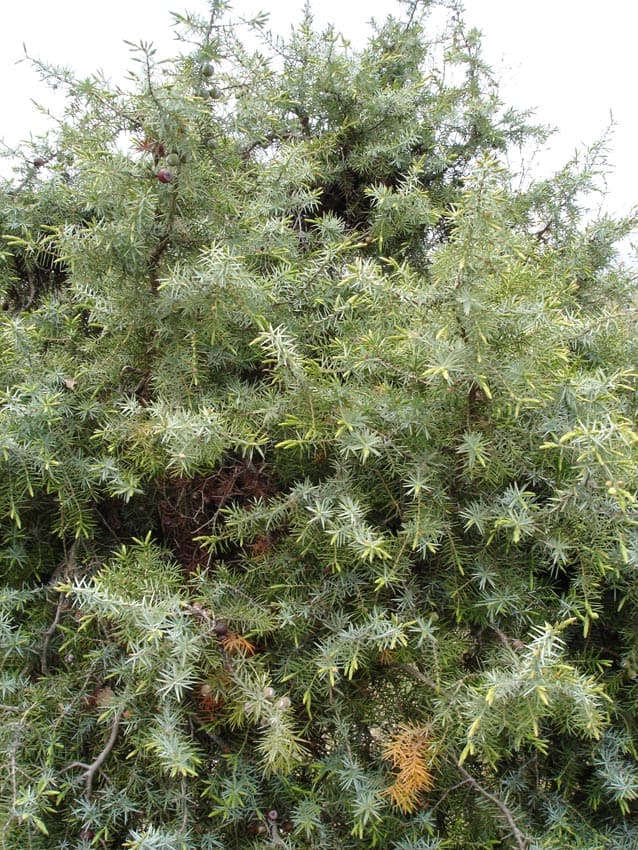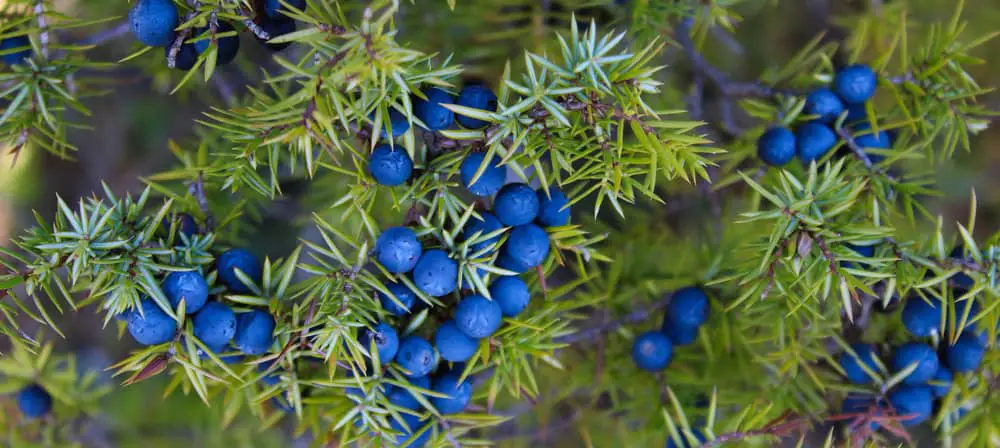Juniper berries have historically been used for medicinal purposes and as a flavoring agent for meats. They’ve also been baked into breads, and they’re an essential ingredient for gin.
This makes it sound like they should be safely considered edible, but the full answer is surprisingly complex. Anyone looking to consume juniper berries will need to be well versed in when they’re safe and when they’re not, because several varieties of juniper berries are actually poisonous.
Are Juniper Berries Edible?
The short answer to this question is a frustrating word: sometimes. This is is probably why so many people have to ask it; they need proper clarification.
One of the reasons this issue gets so complicated is that there are around 40 juniper species. Some species of juniper are fit for human consumption, some are poisonous, and none of the species of juniper should ever be eaten in large quantities. Moreover, while most species are safe to eat in regulated amounts, they’re also bitter fruits that some people enjoy and others really dislike. For example, the eastern red cedar (scientific name: juniperus virginiana) is edible. It’s a very common species of juniper in the Northeast United States. Some people like it, while others think it’s a poor representation of what juniper berries can offer.
Typically, people who enjoy eating juniper berries are eating juniper communis (also called common juniper and shortened to j. communis.). Common juniper is an edible species that is used to make gin.
Juniper berries have been historically eaten in different cultures for generations, so while there are important cautions that wild harvesters should take, the edible fruits are definitely not something you have to avoid altogether. Wild juniper berries are a wonderful treat for the outdoor enthusiast who is confident in the berries they’re gathering. They are more commonly eaten in Russia and Northern Europe, but they grow naturally in North America, Asia, and Europe. They’ve become more popular in dishes in the Middle East over the years.
Juniper Communis has thick leathery skin. Technically, they’re modified seed cones, not berries, and their skin is actually scales, but people have always referred to them as berries since they look like them. They’re green before they ripen, and it’s in their unripe green state, and that they’re used to make gin. Juniper plants sometimes look like shrubs and other times they’re juniper trees.




Juniper Berries Safe to Consume
- Common Juniper (Juniperus communis)– They are the most widely spread juniper found in North America, Europe, Asia, and Africa. Most commonly used to make gin
- California Juniper (Juniperus californica) They are found in California, southern Nevada, northwestern Arizona, and south through Baja California.
- Alligator Juniper or Checkerbark juniper (Juniperus deppeana) They are found in the southwestern United States (Arizona, New Mexico, western Texas) and also northern and central Mexico.
- Utah Juniper (cedar) (Juniperus osteosperma) They are native to the southwestern United States, in eastern California, Nevada, Arizona, western New Mexico, Utah, southern Idaho, western Colorado, Wyoming, and southern Montana.
- Rocky Mountain Juniper, (red Cedar) (Juniperus scopulorum) They are native to western North America, and in Canada, in southwest Alberta and southern British Columbia.
Studies have shown that too many of these berries can cause issues for a human’s digestive system and can cause issues with the kidneys.
Juniper Berries Not Safe
The following Junipers are not safe to consume because all the parts of the plants are filled with toxic compounds and should be avoided. They are used for ornamental gardening. Be sure and know what variety you are dealing with.


- Savin juniper (Juniperus sabina) They are native to the mountains of central and southern Europe and western and central Asia, from Spain to eastern Siberia
- Cade Juniper or Prickly Juniper(Juniperus oxycedrus) They are native to Southwest Europe, northwest Africa, Iran, and Israel.
What Are The Dangers Of Consuming Large Amounts Of Edible Juniper Berries?
People who enjoy eating juniper berries are cautioned not to eat too many of them at once. They’re also cautioned not to eat them on a daily basis. Eating large amounts of common juniper is said to be dangerous. Of course, most people would then like some more details on how much is too much to eat and what those risks are. Unfortunately, while there are warnings not to overdo it, the information on what can happen is somewhat limited. Studies have shown that too many of these berries can cause issues for a human’s digestive system and can cause issues with the kidneys. This is a particularly interesting note since juniper berries have medicinal uses, especially for people suffering from ailments of the kidney, but again, it has to do with the number of juniper berries consumed.
When sold as supplements, companies typically advise consuming one gram of juniper at a time, some going as high as six. However, it’s hard to say how many berries are technically safe to eat, since research on this isn’t extensive.
People with diabetes may want to stay away from juniper berries altogether. Again, the research hasn’t been extensive, but the studies that have been done indicate that it may worsen the symptoms of diabetes.
Are Juniper Berries Used In Essential Oils?
Juniper berries all contain the oil thujone. They’re often used to make essential oil. While different species of juniper may be used, it’s often juniperus sabina (sometimes shortened to j. sabina) that consumers will see on store shelves. Research on the essential oil has suggested that anything more than one gram is dangerous for consumption. As an essential oil, the listed risks include diarrhea, digestive issues, and kidney problems.
Are There Health Benefits To Eating Juniper Berries?
Like many fruits, juniper berries are high in vitamins. In particular, they are high in vitamin C and flavonoid antioxidants.
How Do People Eat Juniper Berries?
Juniper berries smell a lot like gin. They have a citrus tang and a hint of pine. They’re a fairly unique and often bitter-tasting fruit.
Some people will just grab a small handful of ripe fruit when they see common juniper plants while hiking on a trail. Other people will harvest them to add to alcoholic or non-alcoholic drinks. The small berries can add a floral flavor profile. Historically, they’ve been popular with mulled wines.
Juniper berries are also commonly used to season game meats like pheasant, other wild birds, wild boar, and venison. When people purchase them at the grocery store it’s usually for this use. As much as they are used for alcoholic beverages and meat dishes, and sometimes desserts, they’re also great to add as a seasoning for roasted vegetables.
There is a coating that looks like dust on the outside of many juniper berries. This is actually a wild yeast. The yeast has made juniper berries a natural choice for breads, particularly sourdoughs, and has also made juniper a popular choice for some beers.
They can also be added to jams, particularly rhubarb jam, or made into a jam on their own. In Europe, they’re commonly used to make homemade sauerkraut, particularly in Germany.
How Did Juniper Berries Come To Be Used In Alcoholic Beverages?
Juniper berries have been used in mulled wines for a very long time, so it was no secret that they could be used in alcohol. However, in 1650, a man named Dr. Sylvuis was trying to use the berries to help with kidney problems. As he moved forward with his product meant for medicinal use, his creation became popular as an alcoholic drink. Today, we know this as gin.
Native Americans Have A Long History With Juniper Berries
Native Americans enjoyed eating juniper berries and using them for medicinal purposes. Of course, different indigenous tribes found different uses for juniper, but some of the common ways juniper has been used as medicine include treating urinary tract infections, fevers, headaches, kidney stones, sore throats, joint inflammation, and cold symptoms.
More Than Just Gin
While gin may be their most common use today, juniper berries clearly have a long history that shows they’re a lot more useful than simply as a product for gin or other alcoholic beverages. Many people today use juniper trees and shrubs for landscaping, particularly the eastern red cedar variety. Juniper berry tea is a popular treat, and the berries are always appreciated as a seasoning for game meat. With so many species of juniper around, it’s no surprise that such a wide variety of uses has been found for this fruit.
Recent Posts
The only venomous snakes in Washington State are Northern Pacific Rattlesnakes. The Northern Pacific Rattlesnake (Crotalus oreganus oreganus) is a sub-species of the Western Rattlesnake. Anyone...
Skunks are not classified as true hibernators. But they go into a state of torpor when the weather gets cold. Skunks are light sleep hibernators, along with opossums, bears, and raccoons. ...

